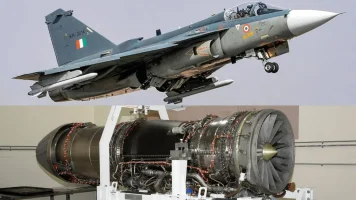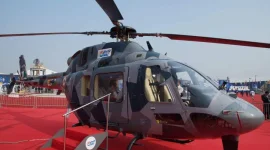- Views: 4K
- Replies: 17
In a major endorsement of India's domestic defence capabilities, the upcoming procurement of 97 Tejas Mk1A aircraft for the Indian Air Force (IAF) will feature the indigenously developed Uttam Active Electronically Scanned Array (AESA) radar.
This decision aligns with the government's Atmanirbhar Bharat (self-reliant India) initiative and signals a growing trust in locally engineered advanced military technology.
To ensure production schedules are met, Hindustan Aeronautics Limited (HAL) is considering a dual-vendor approach for manufacturing the radar systems, pending an evaluation of the primary bidder's capacity to handle the entire order.
The Uttam AESA radar, designed by the Defence Research and Development Organisation’s (DRDO) laboratory, the Electronics and Radar Development Establishment (LRDE), marks a significant technological achievement for India.
Unlike older, mechanically steered radars that physically move to scan the sky, AESA radars use a matrix of hundreds of small modules to electronically direct the radar beam. This allows for near-instantaneous tracking of multiple targets in the air, on the ground, or at sea.
With a reported detection range of over 150 kilometres for fighter-sized targets, the Uttam radar provides superior combat awareness and is harder for enemy aircraft to detect, significantly enhancing the Tejas Mk1A’s lethality and survivability.
The Tejas Mk1A is an upgraded version of the Light Combat Aircraft (LCA) and is a cornerstone of India's military aviation modernization. The aircraft boasts over 60% indigenous content, which includes not only the Uttam radar but also a sophisticated electronic warfare suite and a modern cockpit system.
This new order for 97 jets will supplement the 83 aircraft ordered in a ₹48,000 crore deal in 2021, bringing the IAF's total fleet of this variant to 180.
The aircraft is powered by a General Electric F404 engine and can be equipped with a formidable arsenal, including the indigenous Astra Mk1 beyond-visual-range air-to-air missile and imported weapons like the Python-5.
To avoid potential production bottlenecks that have affected past defence projects, officials are proactively managing the supply chain for the new aircraft.
A dual-vendor strategy for the Uttam radar is being explored, which would involve splitting the production order between the lowest and second-lowest bidders. This approach is intended to create a stable supply of critical components, allowing HAL to maintain its planned aircraft manufacturing pace.
The final decision to split the order will depend on whether the primary vendor can commit to delivering all required radar units within the project's demanding timeline.
The vendor selection for the radar systems will commence after the main contract for the 97 aircraft, estimated to be worth around ₹60,000 crore, is officially signed, which is anticipated by the end of 2025.
The evaluation process will be stringent, ensuring that chosen companies, potentially including state-owned firms like Bharat Electronics Limited (BEL) and private sector partners, meet strict quality and delivery standards.
Implementing a split-vendor model is also expected to foster healthy competition within India's defence industrial ecosystem and encourage further innovation.
The combined force of 180 Tejas Mk1A jets will eventually form nine IAF squadrons, playing a crucial role in replacing the force's aging fleet of MiG-21 aircraft.
To meet this requirement, HAL is scaling up its production capacity with a target of delivering 24 jets per year from its facilities in Bengaluru and Nashik. The
IAF's commitment to the platform is further underscored by its plans to acquire 170 units of the more advanced Tejas Mk2 in the future, which will also integrate the Uttam AESA radar, ensuring a continued legacy for India's homegrown defence technology.



